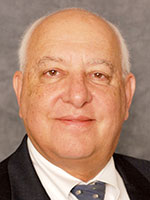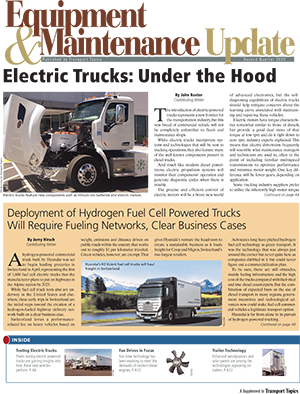Keeping Trucks Rolling Amid Pandemic
[Ensure you have all the info you need in these unprecedented times. Subscribe now.]
American Trucking Associations’ Technology & Maintenance Council, leaders in the development of recommended maintenance and engineering practices for commercial vehicles, is now serving as a conduit of information as to how maintenance operations can sustain, protect and facilitate trucking’s critical role in fighting the novel coronavirus pandemic.
TMC Launches New Resource for Maintenance Operations
TMC has established a COVID-19 community on its collaborative work platform, TMC Connect (tmcconnect.trucking.org), to share information and mitigation practices that its members are using to keep maintenance operations running.
Any member of TMC can join this community and contribute information. The collective wisdom will be assembled in the community’s library, which will include adopted TMC recommended practices, draft RPs and additional information provided by third parties.

Legler
Two existing TMC recommended practices are of particular note.
The first, RP 537, Disaster Recovery for Vehicle Maintenance Operations, offers guidelines for developing a disaster recovery plan covering pre-evaluation, planning and duty assignment of assets, property and personnel. This plan offers a road map for securing alternative resources, providing training and ensuring the safety of personnel and property during a catastrophic event.
The plan is designed to keep critical business functions operating; minimize the duration of service disruptions; limit additional damage and/or loss; establish management succession and emergency powers; facilitate all recovery tasks; and identify critical lines of business and supporting functions.

TMC’s recent survey on COVID-19 impacts on maintenance, discussed further below, revealed that less than half of the responding organizations had maintenance-specific disaster management aspects to their plans.
The second, TMC RP 443, In-Cab Cleaning and Deodorizing, offers guidelines for the in-cab cleaning and deodorizing of commercial vehicles, and provides information on the benefits of establishing a proper vehicle interior cleaning program.
It explores aspect of various methods and chemistries commonly used in the industry. Before the start of the COVID-19 outbreak, TMC’s RP 443 Update Task Force was revising this document to incorporate additional processes and technical improvements, including a procedure on the use of chlorine dioxide (ClO2) to sterilize and disinfect truck cabs.
ClO2 has been commonly used since the 1800s (it’s what keeps municipal drinking water potable) to address bacterial, viral and zoological contamination in industrial settings. While the draft procedure will not be balloted and reviewed by TMC’s membership until the council’s next general meeting, it has been posted to the aforementioned TMC COVID-19 community library as a resource to the industry.
TMC Conducts First Survey to Examine COVID-19 Maintenance Impacts
TMC has released a report of its first survey regarding the impacts of the COVID-19 pandemic on commercial vehicle maintenance. The March 31 report contains an analysis of responses provided by TMC fleet and service provider members.
This first survey, conducted during the early phase of the COVID-19 event in late March, investigated current and anticipated impacts in the areas of technician labor force readiness and commercial vehicle parts supply chains. The survey found that in this time frame, actual average impacts in both areas were minor. However, shop support supplies are more moderately impacted.
TMC members say they expect minor to moderate impacts on the labor and supply chain categories during the next month. The ability to recruit, hire and train new or replacement technicians is reported to be a more immediate problem, with moderate disruptions currently being encountered.
TMC intends to repeat this survey periodically during the pandemic event to measure the ongoing risk to maintenance operations and essential transportation functions. The survey report is accessible on TMC Connect and the council’s public-facing website — tmc.trucking.org.
Meanwhile, the Beat Goes On: TMC Tackles Future Tractor-Trailer Connectivity
New onboard technology and telematics are prompting TMC to rethink current power, signaling and data demands for combination vehicles. At its annual meeting in February, TMC hosted a joint symposium with SAE International to discuss how the industry is starting to approach the combination vehicle as a connected whole.
The panel, facilitated by TMC Technical Director Jack Legler, consisted of SAE’s Bill Gouse; Great Dane’s Christian Lee, who chairs TMC’s Future Trailer Task Force; TMC Future Truck Committee Chairman Anthony Marshall of UPS; SAE Truck and Bus Brake and Advance Driver Assistance System Steering Committee Chairman Dave Engelbert of Haldex; TMC Sensor-Enhanced Maintenance Task Force Chairman Wally Stegall of Morey; and Skip Yeakel of Volvo.
TMC polled attendees on the need to upgrade or replace the SAE J-560 seven-pin connector that has mated power units and trailers for more than 50 years. About 85% agreed there was an urgent need to do so either now or in the near future.
Panelists said future development will rely on cooperative technical leadership among trailer and power unit OEMs, and strong strategic direction from fleets, leveraging both TMC and SAE standards.
Future connectivity solutions will need to incorporate advanced driver assistance systems, or ADAS, into the trailer to provide a complete safety envelope, and be compatible with higher levels of automated driving systems and features such as automated coupling and trailer location.
They will also incorporate various sensor inputs for true sensor data-driven predictive analytics and telemetry for load identification, condition and security, allowing for a multivoltage environment for electrification.
The potential for separate/alternative channels for nonsafety command was also discussed. An illustration of a “smart” trailer command signal and telemetry scheme is illustrated on this page.
To sort out these seemingly limitless and potentially conflicting concepts, TMC recently launched two new task forces to develop recommended practices for future trailer electrical connectivity. Under the chairmanship of Business Accelerants CEO Paul Menig, these groups are conducting a series of webinars this spring in which trailer manufacturers will present their concepts for solutions.
With much crossover participation by TMC members in SAE International standards efforts, the objective is to identify common solutions that will accommodate the millions of trailers that will remain in service for decades, while enabling developers of new technologies to bring new solutions online in a compatible, sustainable manner.
Want more news? Listen to today's daily briefing:




